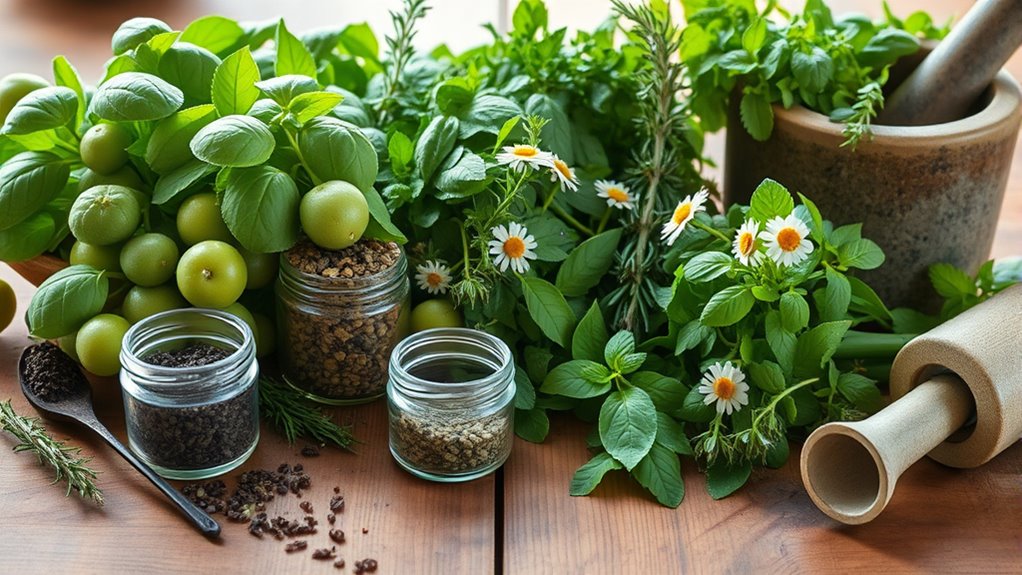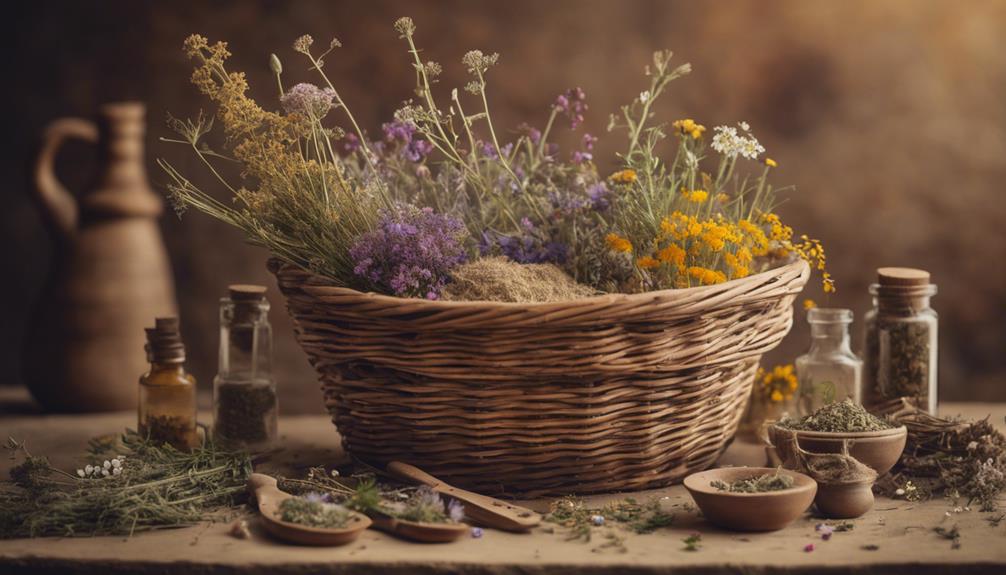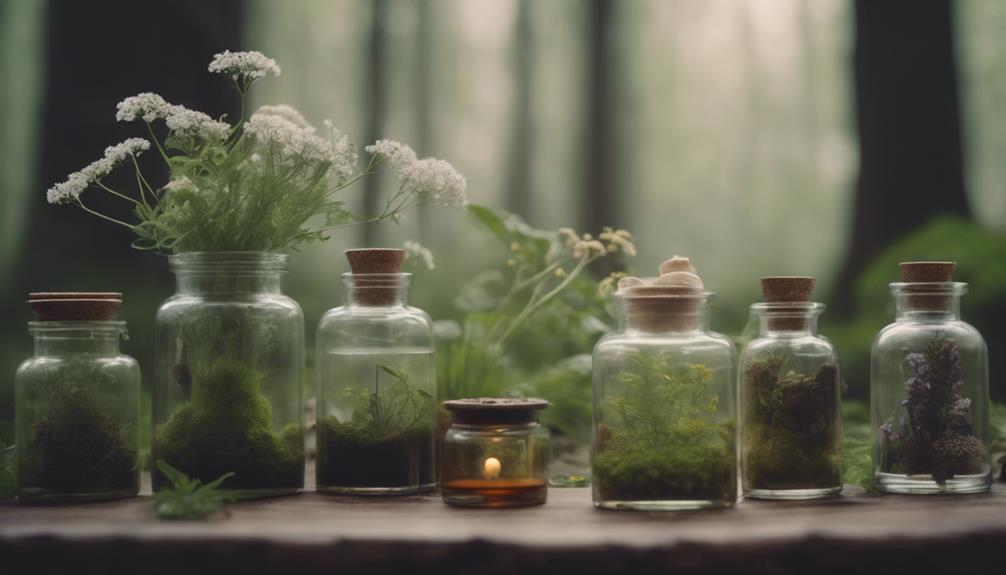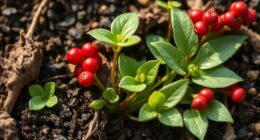Starting your herbal apothecary is easy when you choose versatile, beginner-friendly herbs like chamomile, peppermint, lavender, echinacea, ginger, calendula, dandelion, rosehip, and horsetail. Grow or buy these herbs to make teas, tinctures, salves, and infusions that support your health and wellness goals. Focus on herbs that are simple to harvest and store, and soon you’ll have a powerful collection to start healing naturally. Keep going to discover how to maximize their benefits.
Key Takeaways
- Focus on beginner-friendly herbs like rosehips, horsetail, dandelion, ginger, and lemon balm for immune support and wellness.
- Learn proper harvesting, drying, and storage techniques to preserve herb potency and maximize benefits.
- Incorporate herbs into daily routines through teas, tinctures, salves, and infusions for versatile health support.
- Grow herbs easily in gardens or containers, selecting those suited to your environment and harvest timing.
- Prioritize safe, gentle herbs suitable for beginners to build a foundational herbal apothecary for overall wellness.
Chamomile
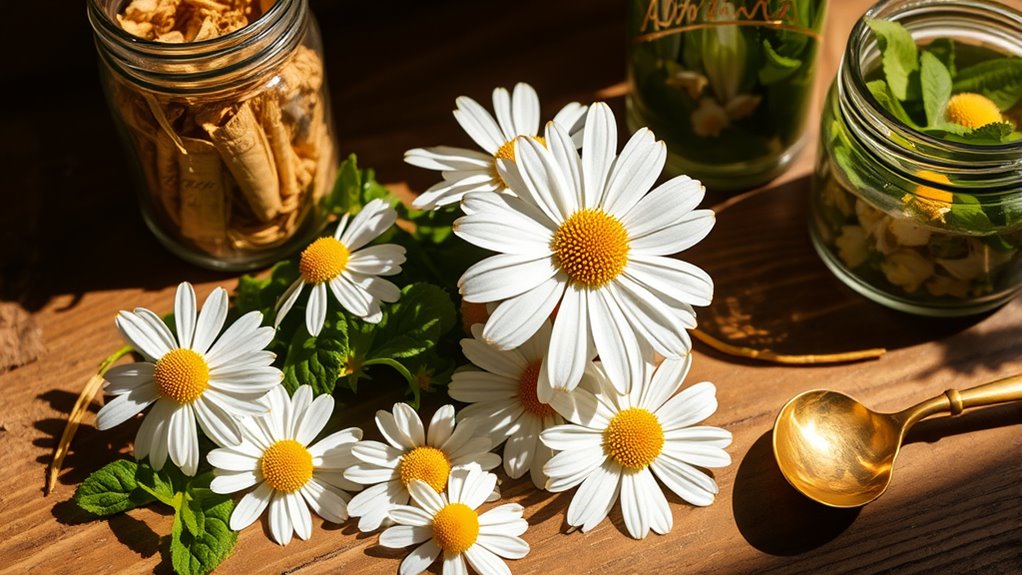
Chamomile is a versatile herb that’s perfect for beginners building their herbal apothecary. Its gentle, calming properties make it a must-have for stress relief and promoting restful sleep. You can easily grow chamomile in your garden or find dried flowers at health stores. When making tea, steep a teaspoon of dried chamomile flowers in hot water for about five minutes. It’s also useful in homemade skincare, thanks to its anti-inflammatory and soothing effects. Chamomile’s mild, apple-like aroma makes it enjoyable to use, and its safety profile means you can incorporate it into your daily routine. Whether you’re dealing with anxiety or skin irritation, chamomile provides a simple, effective remedy. It’s an essential herb to start your herbal collection with.
Peppermint

Have you ever enjoyed the invigorating scent of peppermint? This herb is a must-have in your herbal apothecary because it’s versatile and easy to grow. Peppermint leaves contain menthol, which provides a cooling sensation and helps soothe headaches, indigestion, and nausea. You can harvest fresh leaves for teas, infuse oils, or dry them for later use. Peppermint’s fresh aroma also acts as a natural air freshener or insect repellent. It grows quickly in containers or garden beds, thriving in moist, well-drained soil. Use it to create calming teas or topical remedies. Keep a small jar of dried leaves handy for quick relief or aromatic purposes. Peppermint’s lively scent and healing properties make it an essential herb to start your collection.
Lavender

Have you experienced the calming aroma of lavender? It’s one of the most popular herbs in any herbal apothecary. Lavender’s soothing scent can ease stress, promote restful sleep, and even relieve headaches. You can use it in various forms, such as dried bouquets, essential oils, or infused oils. When incorporating lavender into your collection, consider these options:
- Making calming herbal teas
- Creating relaxing bath soaks
- Diffusing the essential oil for stress relief
- Using dried buds in sachets or pillows
- Preparing homemade skincare products
Lavender’s versatility makes it essential for beginners. Its gentle properties and delightful scent encourage relaxation, making it a wonderful first herb to add to your herbal toolkit.
Echinacea

Echinacea is a powerful herb known for supporting your immune system, especially during cold and flu season. It helps your body fight off infections and reduces the duration of illness. When incorporating Echinacea into your apothecary, consider choosing it in tincture, tea, or capsule form for versatility. Understanding its benefits can help you use it effectively for prevention or early treatment.
| Use Case | Preparation Method | Benefits |
|---|---|---|
| Cold & Flu | Tea or tincture | Boosts immune response |
| Wound healing | Topical application | Speeds up healing |
| General health | Capsules | Maintains immunity |
| Infections | Tincture | Fights pathogens |
| Prevention | Tea or capsules | Supports overall health |
Ginger

Ginger is a versatile root celebrated for its ability to support digestion and reduce inflammation. You can incorporate it into teas, tinctures, or fresh preparations to boost your wellness routine. Its active compounds, like gingerol, provide powerful antioxidant properties and help soothe nausea. Ginger also promotes circulation and can ease muscle soreness. When starting your herbal apothecary, consider these uses:
Ginger supports digestion, reduces inflammation, and soothes nausea with its powerful antioxidants and circulation benefits.
- Fresh ginger slices in teas for digestion
- Dried ginger powder in capsules or recipes
- Ginger tinctures for concentrated support
- Candied ginger as a natural remedy for nausea
- Combining with honey for a soothing sore throat remedy
Adding ginger to your herbal collection provides a flexible, effective herb that benefits many health concerns and adds flavor to your remedies. It’s a must-have for any beginner’s apothecary.
Lemon Balm

Did you know that lemon balm is a gentle yet powerful herb for calming nerves and easing anxiety? It has a soothing scent and a calming effect on your mind and body. You can use fresh leaves to make tea, which helps reduce stress and promote relaxation. Lemon balm also supports digestion and can relieve minor stomach discomfort. Its antiviral properties make it useful for cold sores and other viral infections. To prepare, simply steep a handful of fresh or dried leaves in hot water for 10-15 minutes. Incorporate lemon balm into your herbal routine to enjoy its calming benefits throughout the day. It’s easy to grow at home, making it a practical addition to your herbal apothecary. Keep it nearby for quick stress relief whenever you need it.
Calendula

Calendula is a fantastic addition to your garden because of its proven skin healing properties. It’s easy to grow and thrives in most climates, making it perfect for beginners. Including calendula in your apothecary guarantees you have a natural remedy on hand for skin irritations.
Skin Healing Properties
If you’re looking for a natural remedy to soothe skin irritations, calendula stands out for its healing properties. This versatile herb accelerates the healing of cuts, burns, and rashes by promoting cell regeneration and reducing inflammation. It also has antimicrobial qualities that help prevent infection. When applied topically, calendula can calm itchy, irritated skin and reduce redness. Its gentle nature makes it suitable for sensitive skin, including babies. You can incorporate calendula into your apothecary as a salve, oil, or compress. Keep in mind, its soothing effects extend to minor wounds and sunburns, making it an essential addition to your herbal toolkit for skin care.
- Promotes cell regeneration
- Reduces inflammation
- Prevents infection
- Calms irritated skin
- Suitable for sensitive skin
Easy Garden Growth
Growing calendula in your garden is a rewarding way to guarantee a steady supply of this healing herb. It’s easy to grow and thrives in full sun with well-drained soil. Simply sow the seeds directly into the ground after the last frost, pressing them lightly into the soil’s surface. Keep the soil moist until germination, which usually takes about 7 to 14 days. Once seedlings appear, thin them out to give each plant enough space—about 12 inches apart. Calendula is quite hardy and blooms from early summer until fall, providing vibrant orange and yellow flowers. Regular deadheading encourages continuous flowering. With minimal effort, you’ll enjoy a bountiful garden crop that’s perfect for making herbal remedies and soothing salves.
Dandelion

Have you ever considered how versatile and beneficial dandelions are for your herbal apothecary? These resilient plants pack a punch with their numerous health benefits. You can harvest every part of the plant, from root to flower, making it a true multitasker. Dandelions support digestion, detoxify the liver, and boost your immune system. Plus, they’re easy to grow and maintain in your garden. Incorporate dandelions into teas, tinctures, or salads for a natural health boost. Here are some ways to use dandelions:
- Make herbal tea from leaves and flowers
- Prepare a tincture for liver health
- Use roots for detoxifying remedies
- Add flowers to salads or desserts
- Create a herbal infusion or syrup
Getting familiar with dandelions opens up a world of herbal possibilities.
Rosehip

Rosehip, the vibrant fruit of the wild rose plant, is a powerhouse for your herbal apothecary. Packed with vitamin C, antioxidants, and essential fatty acids, it’s excellent for boosting your immune system and supporting skin health. You can use dried rosehips to make teas, tinctures, or infuse oils, which help harness its healing properties. The tangy flavor makes it a pleasant addition to your herbal remedies. Rosehips also contain anti-inflammatory compounds, making them useful for easing joint pain and promoting overall wellness. When harvesting, look for bright, firm berries that are free of mold or damage. Incorporate rosehips into your collection to strengthen your herbal toolkit and enjoy their versatile health benefits. It’s a simple, effective herb to start with in your journey.
Horsetail

Horsetail is a hardy, ancient plant that offers a wealth of benefits for your herbal apothecary. Known for its high silica content, it supports healthy hair, skin, and nails. It also acts as a natural diuretic, helping to detoxify your body and improve kidney health. You can use horsetail in teas, tinctures, or salves. Its antimicrobial properties make it useful for soothing wounds and skin irritations. Plus, horsetail enhances bone strength due to its mineral richness. When harvesting, look for green, non-woody stems. Store dried horsetail in an airtight container for future use. Incorporate it into your routine to boost your overall wellness naturally. This versatile herb is a valuable addition to any beginner’s herbal toolkit.
Frequently Asked Questions
How Do I Sustainably Harvest These Herbs?
You should harvest herbs sustainably by only taking what you need, avoiding overharvesting, and leaving enough for the plant to regenerate. Always harvest during the right season and time of day for the best potency. Use sharp tools to minimize damage, and avoid uprooting entire plants unless necessary. Practice rotational harvesting, giving plants time to recover, and consider growing your own herbs to reduce wild collection.
Can I Grow These Herbs Indoors Year-Round?
Did you know that indoor gardening can yield herbs year-round, with some studies showing up to 90% success rates? Yes, you can grow herbs indoors throughout the year if you provide adequate light, temperature, and humidity. Use grow lights if natural sunlight falls short, and choose suitable containers. Regular watering and proper ventilation keep your herbs healthy, allowing you to enjoy fresh herbs regardless of the season.
Are There Any Safety Concerns or Interactions?
Yes, there are safety concerns and interactions you should be aware of. Some herbs can cause allergic reactions or interact negatively with medications. Always research each herb thoroughly and consult a healthcare professional before use, especially if you’re pregnant, nursing, or on medication. Keep herbs out of reach of children, and start with small amounts to monitor how your body responds. Being cautious guarantees safe and effective herbal use.
What Are the Best Storage Methods for Herbal Longevity?
Did you know herbs can stay fresh for up to two years with proper storage? To maximize longevity, keep your herbs in airtight containers away from sunlight, heat, and moisture. Store dried herbs in dark glass jars or metal tins in a cool, dry place. Label each container clearly, and avoid opening them frequently to preserve potency. Proper storage guarantees your herbs remain potent and effective for your remedies.
How Do I Identify These Herbs in the Wild?
To identify herbs in the wild, start by studying detailed field guides and plant identification apps. Look closely at leaf shapes, flower colors, and growth patterns. Smell the herbs gently to detect distinctive scents, and examine their stems and roots. Always cross-reference multiple sources, and if you’re unsure, consult experienced foragers or local botanical experts before harvesting. Safety first—never consume wild herbs unless you’re 100% certain of their identification.
Conclusion
Starting your herbal apothecary with these 10 herbs sets a strong foundation. Imagine brewing a calming chamomile tea after a stressful day or using calendula to soothe skin irritation. Just like Sarah, who started small and now crafts her own herbal remedies, you can build confidence and health with these essentials. With a little practice, you’ll discover the healing power of herbs and create a personalized wellness routine that works for you.

